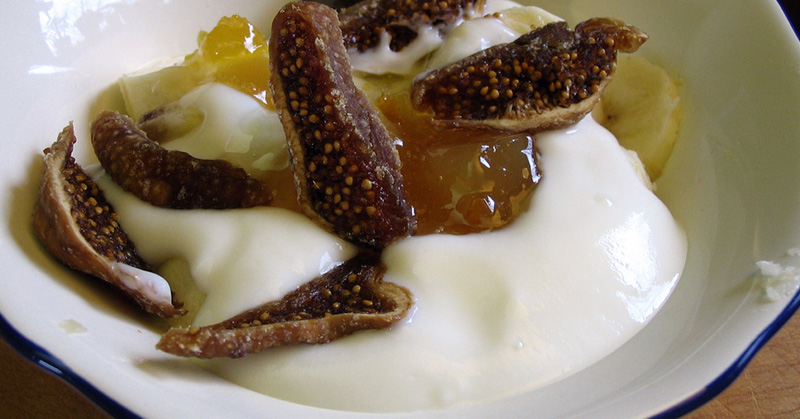
Written by Chef James
Raise your hand if you eat yogurt for the beneficial probiotic properties.
Some people even go so far as to purchase frozen yogurt with the hopes of reaping some sort of healthy benefit. Sorry to burst any bubbles, but commercial yogurt is not what it used to be. Store bought yogurt, by definition, must have minimum of at least 10 million colony forming units of microorganisms which sounds like a lot, but in the culture world, that’s nothing.
Nowadays most yogurt comes with two strains of bacteria whereas traditional ‘heirloom’ cultures were filled with a variety of bacteria that can’t be found in modern yogurts. Similar to the soils of America, we’ve lost the nutrient-density and thus benefits of our yogurt over time.
I say we take back our health and reclaim the benefits of yogurt by making our own.
 It’s a lot easier than you think and traditional cultures are available so you can repopulate your yogurt with strains of bacteria that will make your gut happy.
It’s a lot easier than you think and traditional cultures are available so you can repopulate your yogurt with strains of bacteria that will make your gut happy.
Below is a recipe* for you to make your own yogurt. You’ll need to do a little planning before you start, but once you’ve made your own yogurt you’ll never want the sweetened half-life product sold at the grocery store again.
*This recipe comes approved by New York Times Best selling author Sandor Katz, who I recently met at the WAPF conference. If you’re not familiar with Sandor’s first book, Wild Fermentation, then you’re probably new to the world of fermentation. Sandor is a self taught fermentation experimentalist and has over a decade of experience with culturing. If you’re interested in learning more about fermentation, I recommend his newest book, The Art of Fermentation.
Home-made yogurt
What you’ll need:
- First, choose one of the traditional yogurt starter cultures from Cultures for Health. They have a guide to assist you with choosing the yogurt starter that meet your taste.
- Raw or organic milk (about 1 to 2 quarts)
- Food thermometer
- Mason jar(s)
- Whisk
Directions:
Place the milk in a pot on the stove top over low to medium heat slowly. Using your thermometer, check that the milk heats no higher than 180ºF/82ºC. Once you hit the target temperature, remove the pot from the heat and allow the milk to cool to 115ºF. You may need to gently stir the milk with a whisk to help cool it. Once the milk hits 115ºF/46ºC, add the culture (approximately 1 tablespoon of starter per quart/liter of milk) and mix well ensuring the culture is fully dissolved. Pour the mixture into an appropriately sized mason jar. Cover and seal the jar and then put it in a warm spot like inside your oven with the oven light on. If you have a dehydrator or a yogurt maker, set it to 110º and put the jar into it. Allow to keep at 110º for 4-5 hours.
The milk should now be firmer. You shouldn’t see a lot of whey separation. Place the jar in the fridge and you’re done. You now have homemade yogurt and you get to control what goes in it.
Make sure to save about 1/2 a cup of the yogurt for your next batch. The culture in the yogurt will repopulate your next batch without you needing to buy the culture every time.
Enjoy!




So cool! I love knowing that I can make my own yogurt and it’s that simple. Way to bring it back to the basics in healthy eating and empowering people to make good choices. Love the new Cooking Masterclass blogs.
I just began to make my own yogurt in a similar fashion, sooo yummy! The Nourishing Traditions Cookbook published by Sally Fallon recommends, for raw milk, not heating beyond 110 degrees Farenheit so as not to “kill” the naturally occuring probiotics in the raw milk. I have been following that advice and my yogurt has been turning out great. I’m not aware of a way to check the level of probiotics in my yogurt. What has been your experience?
Hi Kathy, That’s awesome that you’re already making your own yogurt. I’m also amazed that you’re having success making yogurt with raw milk. Most people find the yogurt to be too runny and have inconsistent results.
I also used to follow the rule of thumb of not heating the raw milk above 110ºF, but learned recently from Sandor Katz that denaturing the milk is key to making yogurt. The heat not only kills the native bacteria that could compete with the “yogurt” cultures but the heat also “is to alter the structure of the milk protein, casein, a key to thick, firm yogurt.” Raw yogurt will never be as thick as yogurt heated above 115ºF. If you’re enjoying the consistency of the yogurt you’re already making then don’t change a thing.
If you used store bought yogurt as your culture starter than you’ll definitely not have the amounts of probiotics the more traditional have. You could always purchase the traditional starter and add it to your next batch of yogurt. Don’t change a thing to your recipe except adding the traditional starter. That will pretty much guarantee that you have a probiotic rich yogurt.
Great post! Just what I was looking for. So many complicated recipes out there. This really simplifies it. And I am so happy to have a resource for excellent starter!!
I cannot find products from culture for health where I live. One Of the organic stores in my area sells yougurmet. How is that product? I live in Toronto. Thanks
I haven’t actually tried it before, but you can try it and see ho it goes?
I just read there is some sugar and skim milk in there. I don’t know if that would be a healthy choice..
If they’re adding sugar, then I’d not choose that brand. Bummer that they don’t have Cultures for Health in Canada. Let me reach out to my Canadian peeps for their brand recommendations.